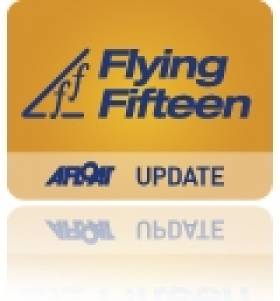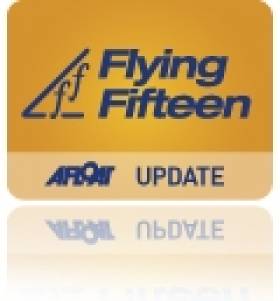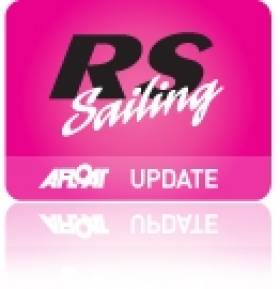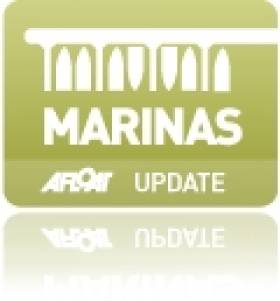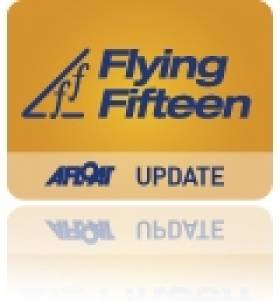Displaying items by tag: Strangford Lough Yacht Club
Gorman & Doorly Win Flying Fifteen Northern Championships
#flyingfifteen – The Flying Fifteen Northern Championships hosted by Strangford Lough YC in Whiterock took place in perfect conditions at the weekend and was won by Dave Gorman & Chris Doorly (NYC) who sailed a very consistent series, Ian Mathews & Keith Poole (NYC) were in second place with Roger Chamberlain & Simon Murray from the local club in third place. There was also a great performance from Lee Statham & Andy Paul (WHSC) who finished fourth in their first event.
On Saturday three races were held in 10-15 knots of breeze from the northwest, the weather mark was out in the Lough so the usual tidal streams had to be negotiated but the PRO PJ Gault set great course's with good start lines. In the first Race Gorman was quick out of the blocks and headed left to stay out of the ebbing tide. He was first at the weather mark but was closely followed by Mathews, Chamberlain and Lawson, this was the way it stayed over the race to the finish.
Race 2: Mathews led the way but on the second beat current Irish Champions McCleery & Dougan took the lead and won the race, behind it was very close with Mathews pipping Gorman on the line for second place. Roger Chamberlain led all the way in Race 3, Gorman had a poor start at the pin end and managed to get back in touch by the weather mark finishing second holding off Lee Statham (WHSC) and Shane McCarty fourth.
After racing most of the competitors had food and refreshments in the club and then adjourned to Daft Eddies for more refreshments. Some visited the Down Cruising Club on board their club the old lightship Petrel which is 100 years old this week.
Sunday was again sunny with a slightly more northerly breeze. There were three boats in contention for the title, Gorman, Chamberlain and Mathews- all to play for! The tide still had an hour to come in, Gorman started at the boat end as there was more breeze on that side of the course and he had the option of tacking in the shifts. This he did and he led at the weather mark but it was all very close, Statham and McKee were close and the lead changed several times with McKee taking the gun, Gorman second, Statham third and Malcolm Crichton fourth. With Mathews fifth and Chamberlain sixth this was enough to give Gorman & Doorly the title. They sailed the last race which was a great race, Statham led the way sailing well but on the last reach he had a problem with the spinnaker and this allowed Gorman through, Statham didn't give up and as they approached the line Gorman lee bowed him to stay in front and take the gun, after over an hours racing there were second between the first five boats, great racing!
At the prize giving local class captain Roger Chamberlain thanked the many volunteers including the PRO and his team, Dave Gorman did likewise but included his long suffering crew Chris. Charlie Boland & Rob McConnell (WHSC) won the Silver Fleet.
The next event is the South Coast Championships which will be held in Dunmore East in July.
Flying Fifteen 2015 Fixtures List Announced
#flyingfifteen – The Irish Flying Fifteen fixtures for 2015 has been announced for 2015. There are two events in Northern Ireland and two in the Republic with the premier event, the Championships of Ireland, confirmed for the National Yacht Club in Dun Laoghaire on September 11th.
There is no announcement yet on a return to Lough Derg's for the Freshwater Regatta in October. The Fifteens travelled to Dromineer for the first time in 2014 but came away with no races sailed after a drubbing at the Tipperary venue.
The full fixtures are as follows:
East Coast Championship, County Antrim YC, Whitehead, 16th-17th May
North Coast Championship, Strangford Lough SC, Whiterock, 13th-14th June
South Coast Championship, Wateford Harbour SC, Dunmore East, 4th-5th July
Championship of Ireland, NYC, Dun Laoghaire, 11th-12th-13th September
#rselite – Strangford Lough Yacht Club were hosts over the 28th-29th June for the 2014 Cardinal Analytics RS Elite Irish Championships writes Mark Fletcher. This was the first Irish championship to be held outside Belfast Lough, due to the newly established SLYC fleet emerging last year. As an added bonus, the event organizers were able to keep the sun shining all weekend. Racing got underway in light conditions on Saturday, and two of the local boats were so keen off the start line they came back for another look after the gun had gone. Thankfully for these two – and without money changing hands – the PRO Davy Young abandoned the race. Within minutes the wind had shifted left and a great breeze filled in which was to stay for the rest of the day.
Results are available to download below as a jpeg file.
In race one Tiffany Brien on Kin took line honours, closely followed by her uncle Mark in Full Marks and Stephen Polly of Storm in third. The rest of the finishes resembled match races, with nothing separating the remainder of the fleet. Race two was a reversal of race 1, with Mark Brien in Full Marks taking line honours from Tiffany Brien in Kin, and Mike Vaughan locking out the final place on the podium. Yet again the following pack was extremely tight, with gains or losses of 3-4 places being spread over several seconds. After a slight break for lunch Race 3 got underway, and it was local boat Tuppence helmed by Brian Corry to cause an upset by holding off the Briens to take line honours. Despite this being their first event, Tuppence had great speed upwind and managed to get in sync with the shifts to hold on for their maiden win. Kin came in second and Storm rounded off the top 3. With the wind forecast for Sunday not looking too exciting, Davy Young wisely opted to sail a fourth race on Saturday when the wind was with us.
The Full Marks boys managed to stay out of trouble all the way round the course and get clean air – no mean feat in such a closely bunched fleet. Jeff Ralston in Upfront sailed a consistent race to come home in second, with fellow RNIYC boat Sea Breezes II helmed by John McDowell coming in third. By this stage the committee boat were getting tired after having to write all the sail numbers down in quick succession, and it was homeward bound for some beer and the championship dinner. Onshore Mark Brien was able to update the Full Marks fans over the phone of their overnight lead.
We weren't privy to the entire conversation but Mark's reply of "don't sound so surprised" must be a quote of the season. General merriment continued all the way to Daft Eddy's, with the Full Marks boys of Marks Brien, Ennis and McNeill confirming they were in full "regatta mode". Day 2 started with no wind, and those who sampled Gerry Reid's concoction/drink the night before were grateful of the delayed start ashore. At least the sun was still shining. After another large wind shift, Race 5 got underway. John McDowell on Sea Breezes II was fast out of the starting blocks and held on to the lead all the way round the course – despite this race being one of the most shifty and patchy in terms of wind of the whole series.
The Full Marks boys had a "sub – optimal" start, and dug deep to recover to 4th, with Jeff Ralston's Upfront taking second and Stephen Polly on Storm rounding out the top three. Unfortunately time ran out and we didn't manage to fit in the final race, but Full Marks had done enough to secure their first Irish Championship win, having sailed an incredibly consistent and fast series. Kin had to settle for second this time round, and Storm were pushed into third by a point. Second to fifth place overall were separated by only 5 points, and further down the overall results were equally tight. This must have been one of the tightest Irish Championships on record, and with multiple Squib, Dragon, Flying Fifteen, Sonata and Laser II champions gracing the start line, the fleet is highly competitive.
SLYC had donated a perpetual trophy to the best placed travelling boat, which went to Carl Allen's More T Vicar of Edinburgh. It was great to see Carl again, who is always a loyal supporter of the Irish fleet. In the first chapter of his acceptance speech Mark Brien thanked the event organizers, PRO, committee boat crew, mark layers and sponsor for putting on a great event. Having said his thank yous and made a move towards his seat he then commenced the second chapter of his acceptance speech when he proposed that SLYC should host the British Championships in the not too distant future – I'm sure that can be arranged!
Strangford Lough Yacht Club is situated in Whiterock Bay in Killinchy, between Comber and Killyleagh. It has a sturdy pontoon linked to the clubhouse that is popular with visiting and local craft alike.
North and South RS Sailors Converge on Hospitable Strangford Lough Yacht Club
Fifteen RS 400s, from as far South as Glandore and as far North as Cushendall formed the main appetiser for the latest RS Ireland traveller series event. A smaller group of RS200s and RS Fevas also battled it out over the two days of the RS Northern Area Championships on glorious Strangford Lough. The racing came courtesy of the most hospitable of hosts at Strangford Lough Yacht Club and their team headed up by Emily Smith and Charlie Horder.
Saturday's racing was a blustery game of snakes and ladders with the RS 400 fleet continually trading blows and producing a different winner in each of the three races.
In the RS200's Heather Craig advised Trevor Fisher on how to do it, as they led overnight with three straight bullets.
In the Feva class, local boys Robbie and Peter Gilmore came good to lead overnight with an impressive score of 1, 3, 1.
The evening brought some "sensible drinking" and fine dining courtesy of event sponsors www.MashDirect.com . Rumours of some out of tune singing also circulated the following morning with some labelling it as Karaoke.
Sunday dawned a bit wet, but as the sun came out, it got even wetter for the back half of the RS 400 fleet as a whooping 30 knot right handed squall cuffed those taking too long to reach the windward mark in race 2, with entertaining variations on how not to bear off, hoist, gybe, stack it etc. Those who did set kites, (which was all but one) where treated to a somewhat out of control reach, (in which most helms would agree, they played very little part) as the mild mannered 400s decided they would steer themselves safely at 20 knots to the downwind position some 200 metres to the right of the last mark. Much swimming was done. There was a welcome rest whilst the PRO rearranged the course for the final race, in lovely sunshine, with some cheeky puffs that allowed all to arrive ashore nicely enthralled by the day's activity.
In the final mix, the Ballyhome duo of Bob "The Laser" Espey and Michael "The other Laser" Gunning took top spot by in RS400 class. Five different winners in six races showed that it was no push over for the lads.
In the RS200 class Heather Craig and Trevor Fisher had the luxury of discarding a second place, the only blot on an otherwise perfect score card to round out a clinical win.
In the Feva class Robbie and Peter Gilmore continued with Saturdays fine form with a 2,1,1 score to take a decisive victory. Perhaps Santa might have to squeeze an RS200 down the Gilmore chimney this year!
Next up for the Irish RS Classes is Greystones and the Sothern Championship on 6th and 7th of October. The local contingent will no doubt be ready to repel the Northern invaders, who are currently very much growing in strength and numbers.
#flyingfifteen – An emphatic win for Dun Laoghaire duo John Lavery and David O'Brien on Strangford Lough yesterday keeps the Irish Flying fifteen title at the National Yacht Club in Dun Laoghaire for another year. The pair took five straight wins in the 23–boat fleet keeping the local challenge from Brian McKee and Steve Martin firmly at bay.
Racing over six races in a variety of conditions from 5-15 knots from Strangford Lough Yacht Club (SLYC) McKee and Martin in turn had a comfortable lead over club mates Roger Chamberlain and Charlie Horder in third with fellow Strangford pairing Andy McCleery and Colin Dougan of Killyleagh YC fourth.
SLYC's Aiistair and Mark Fletcher were winners of the silver fleet.
In 2011 the title was won by Dun Laoghaire's David Gorman and Chris Doorly who were not defending.
The three day event included a unique presentation of Strangford Lough archive yachting footage from the 1930s-70s. Footage included early cine reel of 12 metre and J class yacht racing from a private collection. There were rare glimpses too of early Flying fifteen keelboat competition and a talk by local sailor Peter Browne, who with brother Max, built the first Fifteen in Ireland in 1952. Early black and white images documented the boat under construction and photographs of the maiden sail on the Lough showing the boats wooden spars and cotton sails and a central winch for the jib, a chance for today's fleet to see how much the now fully carbon built Flying fifteens have changed over 60 years.
Next event for the Irish Flying fifteens is at Carrickfergus on Belfast lough on September 15th. The season ends with the East Coast Championships at the National Yacht Club on October 6th.
Strangford Lough Yacht Club
Strangford Lough Yacht Club is situated in Whiterock Bay in Killinchy, between Comber and Killyleagh. It is in an area of outstanding beauty and on the finest sailing waters in Ireland.
SLYC hosts a variety of dinghies and keelboats which race competitvely during the sailing season. These include Rivers, Glens, Clippers, Flying Fifteens, Sonatas, Cruisers and a large dinghy fleet.
Strangford Lough Yacht Club boasts a large number of facilities for our members and visitors.
The club house has a bar and restaurant facilities, along with many other facilities for the boat owners. Situated in Whiterock, the Club commands unbeatable views across Strangford Lough. The Club provides a very active social, educational and sailing programme that maximises the facilities of the club.
Strangford Lough Yacht Club, Whiterock, Killinchy BT23 6PY, N. Ireland. Tel: 02897 541883, fax: 02897 541883, email: [email protected]
Have we got your club details? Click here to get involved





























